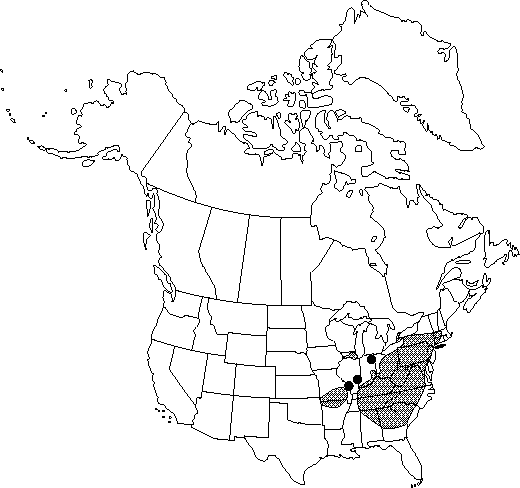Cimicifuga racemosa
Gen. N. Amer. Pl. 2: 15. 1818.
Stems 75-250 cm, glabrous. Leaves: petiole angled or ± terete, 15-60 cm, usually not grooved abaxially, glabrous. Leaf-blade 2-3-ternately compound; leaflets 20-70; terminal leaflet of central segment ovate to obovate, 3-lobed, 6-15 × 6-16.5 cm, with 3 prominent veins arising basally, base somewhat cuneate to somewhat cordate, margins dentate to deeply dentate-serrate or incised, apex acute to acuminate, surfaces glabrous, abaxially rarely pubescent on veins; other leaflets 4-12 × 3-8 cm. Inflorescences erect panicles of 4-9 wandlike, racemelike branches, 10-60 cm, distally pubescent; bracts 1, subtending pedicel, subulate, 3-4 mm; pedicel 4-10 mm, pubescent, bracteoles absent. Flowers: sepals 4, greenish white; petals (1-) 4 (-8), white, oblong, ca. 3 mm, clawed; nectary basal; stamens 55-110; filaments 5-10 mm; pistils 1 (-2), sessile, ± pubescent; style short, thick; stigma 0.5 mm wide. Follicles 1, sessile, ovoid, ± laterally compressed, 5-10 mm, thick walled. Seeds brown, hemispheric, 3 mm, smooth or ± rough-ridged, without scales. 2n = 16.
Phenology: Flowering summer (Jun–Sep).
Habitat: Moist, mixed deciduous forests, wooded slopes, ravines, creek margins, thickets, moist meadowlands, forest margins, and especially mountainous terrain
Elevation: 0-1500 m
Distribution

Ont., Ala., Ark., Conn., Del., D.C., Ga., Ill., Ind., Ky., Md., Mass., Mo., N.J., N.Y., N.C., Ohio, Pa., S.C., Tenn., Va., W.Va.
Discussion
Maine and Vermont specimens probably were planted originally.
Several varieties (A. Gray et al. 1878-1897, vol. 1(1,1), pp. 53-55) or forms (M. L. Fernald 1950) have been named. Specimens with extremely dissected leaves from Connecticut to Delaware and Virginia have been called Cimicifuga racemosa var. dissecta A. Gray, or C. racemosa forma dissecta (A. Gray) Fernald. Of the approximately 2500 specimens of C. racemosa examined, only twelve represent var. dissecta, and only two of those have flowers or fruits. Because of the limited knowledge concerning the dissected-leaf form, and because plants similar to those referred to by Gray and Fernald have not been collected in this century, the form is of uncertain taxonomic significance. Further study is needed.
Native Americans used infusions of plants of Cimicifuga racemosa medicinally to stimulate menstruation, to treat rheumatic pains, coughs and colds, constipation, and kidney trouble, to make babies sleep, and to promote milk flow in women (D. E. Moerman 1986).
Selected References
None.
Lower Taxa
"thick" is not a number.